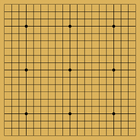
This is what a wooden 19x19 Go board looks like.
A Go board (called goban in Japan) is what people use to play the game of Go on. The heavy black dots on the board indicate the star points on a board. These are placed to help players get their bearings. They also mark the locations that handicap stones are placed on.[1] They are usually made of wood, however, other materials are oftentimes used as well. They can come in two different varieties: floor boards and table boards. One of the oldest Go boards that has survived destruction is a board that is carved from rock dating from the Han Dynasty time period of China.
Sizes and shapes of boards[]
The standard size board is 19x19 and is marked with a 19x19 lined grid. Some 19x19 sized boards had a 13x13 size board on the underside of the board. Smaller boards could have a 13x13 grid or a 9x9 grid (13x13 sized board, and 9x9 sized board respectively) that are often used to play shorter game and to help teach beginners how to play the game. In historical times, a 17x17 sized board was used. The shape that Go boards come in differs from country to country; Chinese boards tend to be square while Japanese boards are oblong, so that they appear to be a square when playing in a normal playing position.
Different kinds of boards[]
Go boards can come in many different types and styles, but are commonly found to be made of wood.

A cardboard Go set
The most common Go board are made of paper, plastic or are laminated. These boards can be folded up and stored with easy accessability. These are mainly used by novices when they don't have access or the ability to buy their own proper set. Go boards have been known to be made by hand on pieces of cardboard in the past.
Go boards made for travel are usually made of metal with magnets in or on the stones so that they stick to the board during travel. People also use large magnetic boards for giving lectures or demonstrations as they help to better illustrate the concepts that the lecturer or demonstrator want to get across.
Table boards are usually made of wood and are commonly 1 to 2 inches thick. They are meant to be placed on a table to play. People like using table boards because the wood grain is very easy on the eyes, and the stones make a very nice sound when put onto the board. Sometimes, these boards are made to fold together, or to be "slotted", and sometimes, these boards have smaller sized grids on the underside. Table boards can be made from particle board, spruce, or katsura. The best kinds of boards are made from kaya, because it has a nice shade of yellow that is easy on the eyes, or bamboo. [2] Bamboo boards are good table boards because they are very durable, however, they are also heavier than the other kinds of table boards, making some people dislike them[3].
Floor boards are not very common, mainly because of how traditional, elegant, and expensive these boards are. They are usually made from a single block of wood and are usually meant to be used on a floor or other surface. They have legs attached to the bottom of the board to make the board easier to play on when playing on the floor. They were used during historical times in Japan when one would sit on tatami mats to play Go. In Asia, important tournament games still play Go using floor boards, and the Chinese version of a floor board are usually not made from a single block of wood, making them look more like a small table with a Go board set into the table. On the bottom of the board is usually a small square part that is taken out of the board. This is done to stop the wood from warping over time and to make the sound that the stones make louder when they hit the board. The best type of floor boards are made from a type of wood called Miyazaki kaya. They are rare, and usually cost a fortune to buy. There are different kinds of Miyazaki kaya floor boards based on the grain of the wood. Itame boards are floor boards that have a irregular, bent wood grain and masame boards have consistant wood grains that run straight across the top of the board. Kaya floor boards can cost more than $20,000, but the most common kaya floor boards cost around $1,000. Floor boards are also made from spruce, agathis, and katsura. These floor boards are cheaper than kaya floor boards; most floor boards made from these kinds of wood only cost between $500 and $1,000. The best maker of floor boards is Japan. China also makes floor boards, but the floor boards they make aren't made from kaya wood. China also makes floor boards out of cherrywood and bamboo.
Taking care of Go boards[]
When buying a Go board, one should always take good care of the board so that it doesn't get damaged. One should keep wooden Go boards in a place that is free of moisture and sunlight, as moisture causes molding, warping, discoloration, woodworm, bleaching, and other types of wear and tear. Transporting Go boards from place to place is discouraged, as it could warp or crack the board if the climate changes. Go boards should be covered with a kind of cloth (silk is the recommended type of cloth) to keep dust off the board. Boards that are heavily used should be treated with carnauba wax every so often. It is not recommended to treat a Go board with any kind of chemical agent, as these tend to damage the board. A slightly damp cloth should be used instead.
References[]